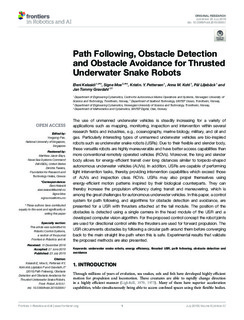| dc.contributor.author | Kelasidi, Eleni | |
| dc.contributor.author | Moe, Signe | |
| dc.contributor.author | Pettersen, Kristin Ytterstad | |
| dc.contributor.author | Kohl, Anna M | |
| dc.contributor.author | Liljebäck, Pål | |
| dc.contributor.author | Gravdahl, Jan Tommy | |
| dc.date.accessioned | 2019-11-15T10:15:11Z | |
| dc.date.available | 2019-11-15T10:15:11Z | |
| dc.date.created | 2019-08-12T14:55:28Z | |
| dc.date.issued | 2019 | |
| dc.identifier.issn | 2296-9144 | |
| dc.identifier.uri | http://hdl.handle.net/11250/2628707 | |
| dc.description.abstract | The use of unmanned underwater vehicles is steadily increasing for a variety of applications such as mapping, monitoring, inspection and intervention within several research fields and industries, e.g., oceanography, marine biology, military, and oil and gas. Particularly interesting types of unmanned underwater vehicles are bio-inspired robots such as underwater snake robots (USRs). Due to their flexible and slender body, these versatile robots are highly maneuverable and have better access capabilities than more conventional remotely operated vehicles (ROVs). Moreover, the long and slender body allows for energy-efficient transit over long distances similar to torpedo-shaped autonomous underwater vehicles (AUVs). In addition, USRs are capable of performing light intervention tasks, thereby providing intervention capabilities which exceed those of AUVs and inspection class ROVs. USRs may also propel themselves using energy-efficient motion patterns inspired by their biological counterparts. They can thereby increase the propulsion efficiency during transit and maneuvering, which is among the great challenges for autonomous underwater vehicles. In this paper, a control system for path following, and algorithms for obstacle detection and avoidance, are presented for a USR with thrusters attached at the tail module. The position of the obstacles is detected using a single camera in the head module of the USR and a developed computer vision algorithm. For the proposed control concept the robot joints are used for directional control while the thrusters are used for forward propulsion. The USR circumvents obstacles by following a circular path around them before converging back to the main straight line path when this is safe. Experimental results that validate the proposed methods are also presented. | nb_NO |
| dc.language.iso | eng | nb_NO |
| dc.publisher | Frontiers | nb_NO |
| dc.relation.uri | https://www.frontiersin.org/articles/10.3389/frobt.2019.00057/full | |
| dc.rights | Navngivelse 4.0 Internasjonal | * |
| dc.rights.uri | http://creativecommons.org/licenses/by/4.0/deed.no | * |
| dc.title | Path Following, Obstacle Detection and Obstacle Avoidance for Thrusted Underwater Snake Robots | nb_NO |
| dc.type | Journal article | nb_NO |
| dc.type | Peer reviewed | nb_NO |
| dc.description.version | publishedVersion | nb_NO |
| dc.rights.holder | Copyright © 2019 Kelasidi, Moe, Pettersen, Kohl, Liljebäck and Gravdahl. This is an open-access article distributed under the terms of the Creative Commons Attribution License (CC BY). The use, distribution or reproduction in other forums is permitted, provided the original author(s) and the copyright owner(s) are credited and that the original publication in this journal is cited, in accordance with accepted academic practice. No use, distribution or reproduction is permitted which does not comply with these terms. | nb_NO |
| dc.source.journal | Frontiers in Robotics and AI | nb_NO |
| dc.identifier.cristin | 1715345 | |
| dc.relation.project | Norges forskningsråd: 223254 | nb_NO |
| cristin.unitcode | 7401,90,26,0 | |
| cristin.unitname | Mathematics and Cybernetics | |
| cristin.ispublished | true | |
| cristin.fulltext | original | |
| cristin.qualitycode | 1 | |

